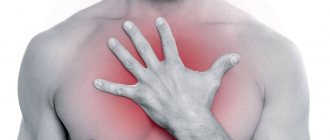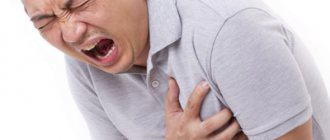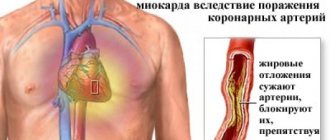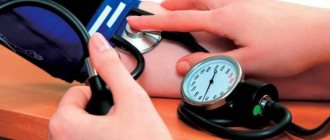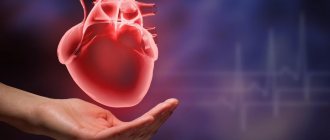Differential diagnosis of cardialgia, neuralgia and myalgia
The most common pathologies that lead to pain under the shoulder blade and in the heart area are as follows:
Diseases of the musculoskeletal system:
- scoliosis;
- osteochondrosis of the thoracic and cervical spine;
- traumatic injuries to the ribs and/or scapula;
- intervertebral hernia in the thoracic region;
- myositis.
- intercostal neuralgia;
- myofascial pain syndrome;
Diseases of the cardiovascular system:
- cardiac ischemia;
- angina pectoris;
- myocardial infarction;
- dissecting aneurysm of the thoracic aorta;
- heart defects (often mitral valve);
- endocarditis;
- myocarditis;
- pericarditis.
Our body is a very complex system where everything is interconnected. Therefore, the reasons for which pain in the heart radiates to the shoulder blade may be problems with the digestive, respiratory and other systems (similar symptoms occur with a stomach ulcer complicated by perforation, GERD, pancreatitis, pneumonia, pleurisy, bronchitis). We also must not forget about the psychogenic etiology of discomfort in this anatomical area. The patient's profession should also be taken into account. The patient's work can often be associated with muscle tension in the shoulder region. Drivers, seamstresses, and machinists are especially prone to this.
How to clinically distinguish cardialgia from pain associated with neurological or muscular origin?
Cardiogenic factors causing pain
There are many pathologies affecting the heart, which can lead to discomfort in the thoracic area and irradiation of pain to the upper limbs, lower jaw, sensation of a lump in the throat and other unpleasant symptoms:
- heart attack;
- aortic aneurysm;
- angina pectoris;
- heart defects, including valvular defects;
- myocardial dystrophy;
- cardiomyopathy;
- hypertension.
Each disease is accompanied by its own symptoms, in addition to chest pain. In processes associated with inflammation, this is an increase in general body temperature, aortitis is an asymmetry of the pulse, an aneurysm when it dissects is accompanied by severe unpleasant sensations that cannot be relieved by nitroglycerin, and a bluish discoloration of the face.
A heart attack is characterized by a feeling of fear, a wave-like increase in symptoms, acute and very strong, burning pain in the area of the left shoulder blade, anxiety, and cold sweat. Nitroglycerin is not able to improve the condition. Angina pectoris is characterized by a specific cardiac cough and a sensation of a lump in the throat. With persistent hypertension during a crisis, patients complain of a lack of oxygen. Violation of the valve apparatus is often accompanied by vestibulopathy (dizziness).
Why does heart pain radiate to the scapula in acute cases?
Irradiation of pain is the body’s ability to spread unpleasant sensations to a distant distance from the place of its origin. The reason for this phenomenon is the structural features of the human body.
During embryogenesis, the heart anatomically developed in parallel with the neck region, upper limbs and part of the back. Therefore, all these areas receive nerve fibers from the same areas of the spinal cord.
Innervation of the heart is achieved by six plexuses, as well as nerve fibers of the spinal nodes. All this provides a fairly wide level of perception and manifestations of discomfort behind the sternum. The irradiation of heart pain is due to the fact that impulses coming from both the “pump” of our body and the shoulder blade are closed in the same place. Based on this, irritation can be freely transmitted from one branch to another, providing polymorphism of clinical manifestations.
Therefore, when pain in the heart radiates to the left shoulder blade, you should not immediately drink handfuls of medications, interpreting this condition as a priori heart attack. Only a comprehensive assessment of your condition will allow you to form preliminary conclusions about your well-being. The final diagnosis can only be made by a specialist.
Stomach ulcer
Pain in the back of the left shoulder blade may be associated with the formation of a stomach ulcer. This disease often occurs in men, but women are no exception. The cause of the development of ulcers can be frequent stress, poor quality food and inappropriate lifestyle.
© shutterstock
Signs of an ulcer
If after eating food a person feels pain in the area of the shoulder blade on the left , which weakens after an attack of vomiting, then this can be considered the first sign of a stomach ulcer. Unpleasant belching and heartburn are secondary symptoms of ulcers, which provoke painful sensations in the left side of the back. Not only the left shoulder blade can hurt, but also the chest.
At such moments, a person cannot fully move, breathe deeply and relax, which can lead to new problems with the functionality of the body and the nervous system. When pain in the left shoulder blade at the back manifests itself intensely, you should immediately seek help from specialists.
Treatment options
Unfortunately, it is not possible to cure an ulcer with a specific medicine. What is needed here is an integrated approach that will help eliminate the causes of pain in the left shoulder blade at the back. And when the acidity of the juice in the stomach decreases, nausea, heartburn and belching will disappear.
Doctors prescribe treatment to a patient:
- Antibacterial therapy;
- Antisecretory drugs;
- Agents that increase the protection of the mucous membrane;
- Additional medications, including antidepressants and painkillers.
The duration of treatment can take from 14 days to 2 months.
Is radiating heart pain an emergency?
How do you understand that a life-threatening condition is developing and there is no time to hesitate?
If there is a sharp pain in the heart and under the shoulder blade, which lasts more than 15 minutes and does not go away after taking nitroglycerin, this indicates the development of an emergency condition.
In addition to pain, acute coronary syndrome may be accompanied by the following symptoms:
- dry mouth, feeling of fear;
- severe lethargy, dizziness, loss of consciousness;
- the veins of the neck pulsate and swell;
- interruptions in heart function, palpitations;
- the left arm and lower jaw may become numb;
- shortness of breath, difficulty breathing due to a feeling of tightness in the chest;
- nausea, vomiting, cold sweating;
- drop in blood pressure;
If at least one of the above symptoms occurs, you must urgently call an ambulance. Often the main reason for the high complication rate is late hospitalization.
Prevention of the causes of such pain syndrome
The World Health Organization identifies three types of prevention of any disease: primary, secondary and tertiary. The meaning of all preventive actions is to prevent pain, reduce relapses and exacerbations of identified symptoms, and recovery after treatment.
Prevention of such pain syndrome depends directly on the type of underlying disease that led to it.
In case of pathology of the heart, the following is indicated:
- lifestyle modification, which includes normalizing weight, giving up bad habits, and dosed physical activity;
- balanced diet with limited salt, animal fats, enriched with vegetables and fruits;
- constant use of medications;
- regular measurement of blood pressure, counting heartbeat (pulse).
For diseases of the musculoskeletal and nervous systems:
- attend physical therapy classes;
- beware of hypothermia;
- regularly change body position to relieve tension from the same muscles;
- undergo massage sessions according to indications.
According to statistics, more than 1/3 of people may complain of heart pain. More than half of these cases are not associated with a myocardial problem. The diagnosis determined determines the quality of further treatment, on which the preservation of health and life depends.
Many people complain that their pain in the heart area radiates to the shoulder blade. This symptom is considered one of the most dangerous, as it often indicates various severe pathologies, including coronary heart disease, even myocardial infarction. It is for this reason that it is so important to know why this symptom occurs and what to do if it occurs.
Causes of pain associated with heart pathologies
A number of ailments have been identified that affect the heart muscle and cause pain in the heart area. The latter radiates to the shoulder blade, arm, and jaw. The nature and strength of pain directly depend on the specific disease, its degree, and concomitant pathologies.
The most common causes of pain are:
- Ischemia.
- Myocardial infarction.
- Valve prolapse.
- Arrhythmia.
Each pathology has its own symptoms. If an inflammatory process is observed, the body temperature rises, aortitis is accompanied by a pulse disorder . With an aneurysm, it is impossible to eliminate pain with Nitroglycerin. The condition is accompanied by a bluish discoloration of the facial area.
Cardiac ischemia
With oxygen starvation of the heart, the risk of developing ischemia increases. The most common cause of oxygen starvation of the myocardium is considered to be a violation of the patency of the coronary vessels that feed the heart.
Coronary heart disease can occur in acute and chronic forms. It is distinguished by a number of symptoms:
- Heart rhythm disturbances.
- High fatigue, general malaise.
- Nausea, vomiting.
- Shortness of breath, lack of air.
- Increased work of sweat glands.
Often, signs of ischemia do not manifest themselves for a long time; often the presence of symptoms resembles disorders in the digestive system, since heartburn and pain appear during meals.
Often the manifestation of symptoms can be confused with mental disorders. Observed:
- Unreasonable anxiety, nervousness.
- Indifference to what is happening, apathy.
- Inexplicable fear.
- Feeling of lack of air, suffocation.
To diagnose the pathology, it is necessary to conduct a series of examinations, which are prescribed by a cardiologist; he is also involved in further monitoring of the patient. If the doctor recommends surgery, a consultation with a cardiac surgeon will be required.
If there is concomitant diabetes or high blood sugar levels, appropriate therapy is required, which is determined by a specialist in the field of endocrine diseases.
Arrhythmia
This is a heart rhythm disorder in various manifestations. The causes of the disease may be different; in order to prescribe adequate therapy, a thorough examination of the patient will be required to determine the etiology of the disease.
Arrhythmia can manifest itself in a variety of symptoms depending on the type of pathology. With bradycardia (slow heartbeat), general weakness, dizziness and fainting appear. Tachycardia (rapid heartbeat) and atrial fibrillation primary symptoms resemble bradycardia.
Frequent fainting conditions due to arrhythmia require urgent resuscitation. With concomitant angina, pain occurs.
The occurrence of pain radiating to the scapula may indicate a myocardial infarction, when there is an urgent need for emergency assistance. The main symptom is the lack of relief from taking medications.
Pericarditis
This is an inflammatory lesion of the serous membrane of the heart; 4 types of pathology are distinguished:
- Spicy.
- Dry.
- Exudative.
- Chronic.
Key reasons
Burning pain near the heart, radiating to the shoulder blade, can occur in a person for various reasons. These could be:
- Ischemic disease. This is one of the most dangerous conditions that can lead to death if the necessary medical care is not provided. The characteristic signs of just such a pathology are: acute pain, a feeling of tightness in the chest, and the appearance of shortness of breath. Such pain in most cases radiates to the left hand.
- Neuroses. Typically, painful sensations with this etymology are periodic in nature and are aching or stabbing. The pain attack itself with such a disease is short-lived. Most often, in patients with this pathology, it occurs against the background of a bad mood.
- Pathologies of costal cartilages. Such pain usually occurs in a person after certain physical activities, even minor ones.
- Rheumatic diseases, as well as heart and valve defects.
- Vascular dysfunction, including the aorta. Most often, with such pathologies, the pain is very sharp, comparable to a penetrating knife wound.
- Pleurisy and other lung diseases. Painful sensations of this etiology are always associated with breathing. They can intensify even with little physical activity.
- Osteochondrosis of the upper spine. Painful sensations with this pathology can be either long-lasting or fairly short-lived. They are provoked in most cases by ordinary turns of the body.
- Infectious diseases. As a rule, they are accompanied by the appearance of a rash on the body. Typically, these symptoms are caused by herpes or chickenpox.
Also, painful cramps in the chest area can be caused by tumors. Rarely, such pain is provoked by gastrointestinal pathologies, including ulcers or spasms of the esophagus. If they occur, as a rule, discomfort is localized only in the chest and is not transmitted to the left arm.
Regardless of the reason why a person has pain in the heart area, this condition cannot be ignored. It is also not recommended to try to provide medical assistance to yourself using non-steroidal drugs, ointments, lotions and compresses, because in most cases they do not have the desired effect. It is important for a person to remember that the sooner he seeks help from doctors, the higher his chances of successful recovery .
Over time, pain and crunching in the back and joints can lead to dire consequences - local or complete restriction of movements in the joint and spine, even to the point of disability. People, taught by bitter experience, use a natural remedy recommended by orthopedist Bubnovsky to heal joints. Read more"
Diagnostics
If pain is detected in the heart area, which also radiates under the shoulder blade, a person should immediately consult a cardiologist or at least a therapist. This should be done immediately in cases where chest pain is accompanied by vomiting, numbness of the limbs, shortness of breath, hemoptysis, and loss of consciousness. In such cases, you need to call an ambulance and report a possible heart attack. Delay in such a situation can lead to the death of the patient.
If there are no such symptoms, the patient is recommended to visit a specialist on the same day or, in extreme cases, the next day. The doctor will have to examine the patient and prescribe a number of additional tests, based on the nature of the complaints and general condition. Such studies could be:
- electrocardiogram;
- X-ray;
- ultrasound examination of the heart and blood vessels;
- tomography;
- treadmill test;
- MRI (if there is a suspicion of spinal pathology).
Additionally, the patient may be prescribed a consultation with other specialized specialists, among whom may be a gastroenterologist, neurologist, pulmonologist, dermatologist, orthopedist, medical psychologist (if neuroses are suspected). Only this approach to diagnosis will make it possible to identify the pathology that provokes pain and prescribe adequate treatment to the person.
Have you ever experienced constant back and joint pain? Judging by the fact that you are reading this article, you are already personally familiar with osteochondrosis, arthrosis and arthritis. You've probably tried a bunch of medications, creams, ointments, injections, doctors and, apparently, none of the above has helped you. And there is an explanation for this: it is simply not profitable for pharmacists to sell a working product, since they will lose customers. Read more"
In most cases, a person whose pain in the heart area radiates to the shoulder blade is prescribed conservative treatment. Depending on the cause of this symptom, non-steroidal drugs may be prescribed; for neuralgia, local warming agents and painkiller injections. In case of severe heart attacks, a person will be prescribed complex therapy in a hospital setting, aimed at normalizing the functioning of the heart muscle. For infectious diseases of the lungs, the patient will be prescribed antibacterial therapy.
If the pain in the area of the left shoulder blade was caused not by cardiac factors, but, for example, by a pinched nerve, the person may be prescribed manual therapy. It is also recommended to undergo it from a rehabilitation specialist, since self-massage or massage performed by a non-professional can harm the patient even more.
In some cases, for example, with pathologies of the main vessels, heart valves, as well as with the appearance of tumors, a person will be prescribed surgical treatment. As part of this, the surgeon can perform valve plastic surgery or create a bypass path for blood flow. After such an operation, the patient may be prescribed complex rehabilitation therapy.
Pain appearing on the left under the shoulder blade is a fairly common symptom that can occur in men, women, and even children. At first glance, such symptoms seem frivolous, but in fact, pain under the left shoulder blade from the back can be a harbinger of a number of dangerous diseases.
There are many reasons for the occurrence of such pain syndrome, and they are usually not at all associated with problems in the shoulder blades themselves. Most often, the cause of pain is inflammatory and pathological processes in other organs and systems.
Pain under the left shoulder blade should not be underestimated, as it may be a signal of one of the serious diseases
Why does it hurt under my left shoulder blade?
To understand why it hurts under the shoulder blade, we need to remember the anatomical structure of a person. After all, most often it is those organs that are located nearby that hurt, although it happens that pain radiates along nerve fibers far from the source of the disease.
The left shoulder blade is located on the ribs that form the chest. The ribs are connected to each other by ligaments and intercostal muscles, and between each rib there are intercostal vessels and intercostal nerves. In turn, the intercostal nerves arise from the spinal cord, which is located in the spinal trunk central to the scapula. Together with the ribs, the scapula protects the left heart, left lung, stomach, spleen, pancreas and aorta.
Based on this location, the causes of pain can be divided into two main groups:
- Pain associated with disorders of the musculoskeletal system, as well as muscle pain.
- Pain associated with pathological changes in the functioning of internal organs (diseases of the gastrointestinal tract, cardiovascular system, spleen, respiratory organs).
The cause of pain in the scapula can be determined based on its nature, intensity and location:
- Pain radiating to the left shoulder blade . The pathological source of such pain may be located far from the site of pain. Most often, this symptom is characteristic of diseases of the stomach or heart.
- Aching pain under the left shoulder blade . Indicates the presence of a protracted chronic process. Such painful manifestations may be associated with chronic heart diseases (pericarditis, myocarditis), as well as with osteochondrosis of the cervical spine.
- Dull pain under the left shoulder blade . Most often it occurs against the background of the development of thoracic or cervical osteochondrosis. Typically, pain spreads down from the back of the head along the back, arm, under the shoulder blade and is accompanied by nausea, dizziness, numbness (tingling) of the hands.
- Severe pain under the left shoulder blade . Intense pain is not typical for the scapular area, and therefore serves as a signal of a pathological condition that can be life-threatening. At best, severe pain may indicate intercostal neuralgia, but more often such sensations indicate the presence of a peptic ulcer and the development of a pre-infarction condition.
- Sharp pain under the left shoulder blade . Intercostal neuralgia can cause sharp pain - while inhaling, the pain syndrome clearly intensifies, and there is a feeling that you are “taking your breath away.” Sharp pain can be caused by left-sided pneumonia in the acute phase, while the patient feels cutting and stabbing symptoms in the entire left side of the chest, radiating to the left shoulder blade. Less often, sharp pain can occur during exacerbation of pancreatitis - the pain is girdling and cramping in nature.
Most often, pain under the left shoulder blade is caused by diseases of the heart or stomach.
- Drawing pain under the left shoulder blade . May indicate the initial stage of development of cervical osteochondrosis. The pain begins just below the occipital bone and radiates to the left (or right) side of the back.
- Burning under the shoulder blade . This symptom may indicate prolonged intercostal neuralgia, angina attacks, or myocardial infarction. Sometimes, the appearance of a burning sensation under the scapula may indicate the development of vegetative-vascular dystonia. In this case, the pain is accompanied by tachycardia, hand tremors, and a strong feeling of fear.
- Constant pain under the shoulder blade on the left . Such pain syndrome may indicate the development of left-sided pneumonia. In this case, the pain is accompanied by a dry cough, low temperature, a feeling of lack of air, and shortness of breath.
- Stitching pain under left shoulder blade . Stitching pains (so-called “lumbago”) are most often a sign of osteochondrosis, but can also indicate intercostal neuralgia. Tingling in the back that occurs during physical exertion, deep breathing, or coughing may be signs of the development of pleurisy or pneumonia.
- Pressing pain . Indicates the development of osteochondrosis, and may also indicate the initial stage of coronary heart disease and exacerbation of vegetative-vascular dystonia.
- Throbbing pain . Most often, left-sided protrusion of the intervertebral disc in the thoracic or cervical spine manifests itself in this way. Throbbing pain may indicate a herniated disc or incipient aortic dissection.
- Sharp pain under the left shoulder blade . They indicate dangerous conditions and require immediate medical intervention. The causes of pain syndrome can be: angina attacks, left-sided protrusion of the intervertebral disc, gastric ulcer.
The nature of the pain and its location may vary, but most often pain under the left shoulder blade is a very dangerous symptom that requires immediate medical intervention.
What diseases can cause pain under the left shoulder blade
Painful syndrome on the left under the scapula is most often caused by pathologies of the musculoskeletal system, heart, stomach and bronchopulmonary system.
Let's consider possible diseases accompanied by pain under the left shoulder blade and the accompanying symptoms.
This has happened to everyone: for no apparent reason, pain suddenly appeared in the heart area, in the back. An unpleasant, frightening feeling when the worst fears arise and you want to call an ambulance.
But is the pain in the left scapular region really that dangerous? What can trigger this syndrome? Can the heart hurt from the back?
How dangerous are the painful manifestations?
Any pain, even short-term and mild, indicates the onset of some disease in the body. Pain in this localization may have causes:
- heartfelt,
- not related to the cardiovascular system.
Mediastinal pathologies
Most often, angina mimics esophageal spasm. Without additional examinations, these conditions are difficult to differentiate, since the patient’s well-being improves after taking nitroglycerin, while he experiences characteristic signs of cardialgia - pain in the heart, scapula, and chest area. In addition, discomfort in the described part of the body may be accompanied by:
- tracheitis;
- mediastinal emphysema;
- embolism of the artery supplying the lungs.
The pathologies are characterized by a dry cough and burning chest pain. With emphysema, the patient is bothered by shortness of breath and sensations of pressure; with embolism, fainting and death are possible.
Diseases of the cardiovascular system
A symptom of these diseases may be pain in the heart that radiates to the back. Almost all of them are dangerous, and failure to see a doctor in a timely manner can lead to serious complications and sometimes even death. Here are some of the diseases:
- Myocardial infarction. Back pain opposite the heart may be caused by a blood clot obstructing normal blood flow. The pain is described by patients as squeezing or pressing and can radiate to the neck, left arm, lower jaw or front of the chest. They last a long time, taking simple analgesics (spazgan, analgin) gives a weak effect. Sometimes such symptoms may be accompanied by nausea, cold sweat, and shortness of breath.
- Angina pectoris. This disease develops gradually, due to the deposition of fatty plaques in the heart arteries, interfering with the normal blood supply to the organ. It often appears after physical work or a stressful situation. As a rule, it is characterized by pain in the front of the chest, but pain may occur in the heart area from the back. A distinctive sign of angina is considered to be short-term squeezing or squeezing pain. The first symptoms of pain are not severe, but increase as the disease progresses.
- Pericarditis (inflammation of the heart sac) is caused by various viral infections and is manifested by acute, stabbing pain. Associated symptoms are often weakness and low-grade fever.
- Aortic dissection (rare) due to injury to the thoracic spine or chest. May develop due to uncontrolled hypertension. Painful sensations appear suddenly and severely.
Acute pancreatitis
Acute pancreatitis is inflammation of the pancreas. This disease can also cause back pain in the area of the shoulder blades on the left. In addition, a person loses appetite and digestion is disrupted. Pain occurs after consuming food or alcohol.
© shutterstock
Signs of pancreatitis
In acute pancreatitis, not only the scapula, but also the left hypochondrium is of concern. The pain is constant, even when the person is in a supine position. Signs of the disease include :
- Nausea;
- Vomiting;
- Heartburn;
- Bloating;
- Temperature increase;
- General weakness;
- Skin manifestations.
When a person detects such signs and pain from the back to the shoulder blade, this is an obvious sign that the body needs proper diagnosis and treatment.
Treatment options
For acute pancreatitis, therapeutic assistance is provided . The patient is prescribed bed rest and the necessary medications, including antibiotics and detoxification therapy. Nutrition is provided parenterally.
There are cases when acute pancreatitis requires surgical intervention : stones in the bile ducts, abscesses, fluid accumulation in the gland.
This disease can develop severe complications, the untimely treatment of which can be fatal.
If pain in the back of the shoulder blade does not give you peace, you should seek help from highly qualified medical professionals.
Diseases of other organs or systems
Painful manifestations on the left are not always caused by cardiac causes. They can also be caused by diseases and injuries:
- Osteochondrosis of the chest or neck can provoke a sharp prick on the left side of the chest, similar to manifestations of angina pectoris. The sensations radiate to the arm or interscapular area and intensify with movement.
- A herniated thoracic spine that puts pressure on the heart. This disease occurs rarely due to the fact that this vertebral region is inactive.
- Injury to the ribs on the left, accompanied by pinched nerves, causes pain along the entire costal arch. Manifestations radiate to the scapula, giving clinical manifestations similar to angina pectoris.
- Tietze syndrome, when inflammation of the costal cartilages occurs, can be confused by clinical manifestations with a heart attack or angina pectoris.
- Fibromyalgia and other inflammations of the muscles of the left upper back. Pain is also observed when raising the arm or turning the body.
- Panic attacks, when sudden palpitations with a feeling of lack of air provoke a pain syndrome that manifests itself individually in each person. Differential diagnosis with cardiac pathologies will be an ECG.
- Lung diseases such as pleurisy, pneumothorax, and bronchial asthma can provoke pseudocardiac pain syndrome. A distinctive feature of pulmonary diseases is the patient’s complaint that when he lies on his back, his heart hurts. As a rule, these people prefer to rest on their left side to improve their well-being.
- Disorders of the stomach and esophagus (spasms, heartburn, gastritis) give clinical symptoms similar to those of the heart. They often radiate to the left under the scapula, worsening when bending over or lying on the back.
- During inflammatory processes, the gallbladder and pancreas can also extend under the left shoulder blade, creating the illusion of heart pain.
Even mild, short-term pain in the heart area, arising from the back on the left, should not be ignored, especially if additional symptoms (shortness of breath, hyperthermia) are associated with them.
It is better to go to the clinic immediately. Perhaps nothing terrible happened, or perhaps a serious illness will be detected, and timely treatment will help maintain health.
A selection of my useful materials on the health of the spine and joints, which I recommend you watch:
Also check out a lot of useful additional materials in my communities and social media accounts:
Denial of responsibility
The information in the articles is for general information purposes only and should not be used for self-diagnosis of health problems or for therapeutic purposes. This article is not a substitute for medical advice from a doctor (neurologist, therapist). Please consult your doctor first to know the exact cause of your health problem.
Chest pain is a symptom of many diseases, not necessarily heart diseases. Thus, diseases of the musculoskeletal system, respiratory and digestive organs, neurological disorders, and injuries may manifest themselves. However, you need to know how to determine if your heart is hurting, since this is where immediate help may be needed. It is especially important not to miss a dangerous condition, such as myocardial infarction.
Only a doctor can make a diagnosis, but some specific signs will help you understand that your heart is hurting.
The nature of pain in cardiac diseases
Angina attack
The pain occurs behind the sternum, it can be squeezing, squeezing, sometimes cutting, but never sharp, but always dull. It arises exactly where the heart is. The person cannot pinpoint exactly where it hurts and puts his hands all over his chest. The pain radiates to the area between the shoulder blades, to the left arm, jaw, and neck. Usually appears during emotional stress, physical exertion, when leaving a warm room in the cold, while eating, at night. When your heart hurts, the discomfort lasts from a few seconds to twenty minutes. Usually the patient freezes in place, he develops shortness of breath, a feeling of lack of air, and a feeling of fear of death. Significant relief or complete relief of the attack occurs immediately after taking nitroglycerin. Pain in the heart does not depend on the position of the body, inhalation or exhalation.
Myocardial infarction
Sudden sharp pain behind the sternum of a pressing or burning nature, radiating to the left side of the chest and back. The patient feels as if there is a very heavy burden on his heart. A person experiences a feeling of fear of death. During a heart attack, breathing quickens, and the patient cannot lie down; he tries to sit up. Unlike angina, pain during a heart attack is very sharp and can be aggravated by movement. They cannot be removed with the usual medications for the core.
Inflammatory heart diseases
Heart pain occurs during inflammatory processes such as myocarditis and pericarditis.
With myocarditis, the sensations are almost the same as with angina pectoris. The main signs are aching or stabbing pain, radiating to the left shoulder and neck, a feeling of pressure behind the sternum, usually a little to the left. They are almost continuous and long-lasting, and can intensify with physical activity. After taking nitroglycerin, do not release it. Patients suffer from attacks of suffocation and shortness of breath during physical work and at night, swelling and pain in the joints are possible.
Signs of pericarditis are moderate, dull, monotonous pain and fever. Painful sensations can be localized in the left side of the chest, usually above the heart, as well as in the upper left part of the abdomen, the left shoulder blade. They get worse when coughing, when changing body position, when breathing deeply, or when lying down.
Aortic diseases
Aortic aneurysm is expressed by pain in the upper chest, which lasts several days and is associated with physical effort. It does not spread to other parts of the body and does not go away after nitroglycerin.
Dissecting aortic aneurysm is characterized by severe bursting pain behind the sternum, which may be followed by loss of consciousness. Emergency assistance required.
Pulmonary embolism
An early sign of this serious disease is severe chest pain that gets worse when you inhale. Resembles the pain of angina, but does not radiate to other parts of the body. Doesn't go away with painkillers. The patient experiences severe shortness of breath and palpitations. There is a bluish appearance of the skin and a rapid decrease in pressure. The condition requires immediate hospitalization.
Myocardial infarction
Myocardial infarction is an ischemic heart disease. The myocardium is the heart muscle that functions throughout life. Every second it needs a plentiful amount of oxygen in order to function fully. The slightest deficiency will lead to significant heart problems.
When the left shoulder blade hurts from behind, this is the initial signal of myocardial infarction. It is divided into several anatomical locations. Sometimes, the disease awakens painlessly.
© shutterstock
Signs of myocardial infarction
The leading symptom of this disease is severe, burning pain in the area of the left shoulder blade . It is able to flow into different directions and parts of the body: into the neck, arms, chest and even into the jaw. The pain lasts for quite a long time, and nitroglycerin does not help relieve the pain.
In addition to the fact that the left side of the back hurts, the person becomes pale. His body may break out in an icy sweat. The fear of death begins and blood pressure drops.
In some incidents, myocardial infarction can manifest itself as increasing shortness of breath, which is similar to bronchial asthma. But people suffering from diabetes may not notice attacks of myocardial infarction at all, since in them this disease manifests itself in a painless form.
Treatment options
If a person experiences pain in the back of his left shoulder blade, he should seek help from a hospital, and under no circumstances engage in self-diagnosis or self-treatment, as the acute form of the disease can be fatal.
At the first attacks you should call an ambulance . The patient must be hospitalized in a hospital within 6 hours in order to protect against unforeseen consequences.
The hospital performs coronary angiography, plus a set of necessary first aid measures.
Then inpatient drug treatment is prescribed. The patient is given strong narcotic painkillers to help relieve pain in the left side of the back and more. Plus, drugs that reduce blood clotting. Humidified air is supplied using oxygenation. ECGs are performed regularly and blood samples are taken for analysis.
Pain of non-cardiac origin
Intercostal neuralgia
Intercostal neuralgia is often mistaken for heart pain. It does resemble angina, but there are significant differences. Neuralgia is characterized by a sharp shooting pain, which intensifies with movements, turns of the body, coughing, laughter, inhalation and exhalation. The pain may go away quickly, but can last for hours or days, intensifying with every sudden movement. Neuralgia is localized locally on the left or right between the ribs; the pain can radiate directly to the heart, lower back, back or spine. Usually the patient can pinpoint the exact location of the pain.
Osteochondrosis
With thoracic osteochondrosis, a person experiences pain in the heart, which radiates to the back, upper abdomen, shoulder blade and intensifies during movement and breathing. There may be a feeling of numbness in the interscapular area and left arm. Many people mistake their condition for angina, especially if the pain occurs at night and there is a feeling of fear. You can distinguish heart pain from osteochondrosis by the fact that in the latter case nitroglycerin will not help.
Digestive diseases
Symptoms of acute pancreatitis are very severe pain that can be mistaken for heart pain. The condition is similar to a heart attack, and in both cases nausea and vomiting are possible. It is almost impossible to remove them at home.
With spasm of the gallbladder and bile ducts, it seems that the heart hurts. Although the liver and gall bladder are located on the right, severe pain radiates to the left side of the chest. In this case, antispasmodics help.
Severe pain due to a hernia of the esophagus (the opening of the diaphragm) is similar to angina. It appears at night when a person is in a horizontal position. Once you take a vertical position, your condition improves.
central nervous system
With disorders of the central nervous system, frequent and prolonged pain is observed in the chest area, namely in the apex of the heart, that is, in the chest from the bottom left. Patients describe the symptoms differently, but, as a rule, these are constant aching pains, which are sometimes acute and short-lived. Pain due to neuroses is always accompanied by sleep disturbances, irritability, anxiety and other manifestations of autonomic disorders. In this case, sedatives and sleeping pills help. A similar picture can be observed during menopause.
In some cases, cardioneuroses are difficult to distinguish from ischemic heart disease, since there may be no changes on the ECG in both cases.
